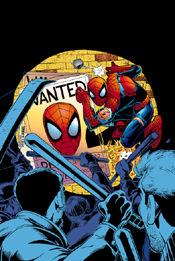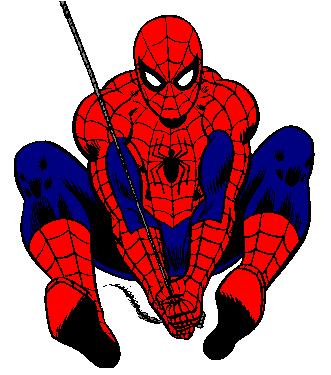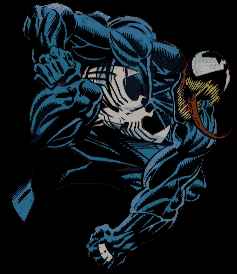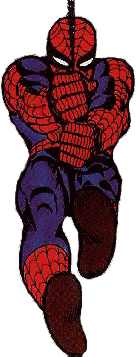The Amazing Spider-Man

Hear the awesome '60s theme song (BIG file, be warned)
Look out!
Here is my section about the amazing Spider-Man, who is by far my favorite comic book character (as well as Stan Lee's, he said so himself!). I wasn't sure what to put up here at first, but then I remembered the article from Spidey's 30th anniversary issue from way back in '92, and I thought everyone else might like to read it too; it's a very good piece about ol' Web-head's first three decades.
SPIDER-MAN: The First Thirty Years
by Peter Sanderson
(originally appeared in Amazing Spider-Man #365, August 1992)
By 1962, Stan Lee and Jack Kirby had already redefined the world of super hero fantasy with their first major joint creations, The Fantastic Four and The Incredible Hulk. Yet neither the Fantastic Four nor the Hulk were super heroes in the traditional sense. In the early 1940s the term "super hero" did not yet exist; instead these costumed adventurers were known as "mystery men". That concept of "mystery" seemed essential to most of the traditional super heroes up until very recent times. Most of them had secred identities; they were "ordinary" people who put on masks and costumes in order to display their extraordinary abilities in fighting menaces to society. After their first issue, there was nothing "mysterious" about the Fantastic Four. They wore no masks, their costumes were no more than practical jumpsuits, and everyone knew who they were. The Hulk originally had a secret identity, but he was as much a potential menace as he was a "super hero".
It was not until 1962 and Amazing Fantasy #15 that "The Marvel Age of Comics" produced its first major masked crimefighter. But Stan Lee and Steve Ditko's creation, the amazing Spider-Man, was like no costumed crimefighter that had preceded him, and completed the revolution of the entire super hero genre that The Fantastic Four had already begun.
Consider first Spider-Man's name. Stan Lee has written in the past how he was discouraged from naming the character after a spider (or the Spider, a masked vigilante of 1930s pulp fiction), since everyone found spiders repulsive. (By the same logic, I suppose, a hero named after a bat could never be popular, either.) But in the early 1960s, super heroes over at the Distinguished Competition were clean-cut, cheerful individuals, motivated only by a sense of idealism, beloved by the public they served, operating in a brightly lit, squeaky clean world without any sense of danger apart frorm the occasional costumed crook robbing a bank.

The eerieness of a man with spider-like abilities provided a startling contrast to these characters. Spider-Man wore a mask that completely concealed any facial expression, and that, in fact, made him look inhuman. He scurried up walls with the strange, animal-like gait which Steve Ditko endowed him. He often operated at night, frightening his criminal adversaries by catching them in the glare of the spotlight cast from his belt.
If Spider-Man was eerie, then his principal costumed opponents were downright grotesque. Lee and Ditko succeeded in fusing the costumed super-villain with the memorably repellent villains of the Dick Tracy mold. Some, like Spider-Man himself, blended the aspects of animals and human beings: Doctor Octopus, the Vulture, the Lizard, the Scorpion, and the Chameleon. Others seemed to overturn the natural order of things by their very existence: the Sandman, who could turn his human form into a torrent of living sand; Mysterio, who used his knowledge of special effects to perform the seemingly impossible--even to appearing not to have a head! Perhaps most memorably, there was the Green Goblin, who looked like a medieval gargoyle come to life, a human in demonic form, possessed of the "black magic" of modern science.
Furthermore, Spider-Man did not live in some fictional metropolis, but in a city clearly identified as New York. And Steve Ditko's New York was not a fantasy world of gleaming, modern skyscrapers, but a city with dark alleys, water towers atop buildings that were clearly many decades old, dilapidated warehouses, dank sewers. It was also infested with thugs and gangsters, leading to the many tales of organized crime that have run through Spider-Man's entire history, ranging from the early stories of the Big Man and Crime-Master through the many memorable sagas of Spider-Man's one-man wars against the Kingpin's criminal empire.
This was a dangerous world, and in part Spider-Man was the dark avenger who took it upon himself to hunt down its criminals. No scene shows this better than the climax of Amazing Fantasy #15 itself, in which Spider-Man climbs down a wall in a darkened warehouse, terrifying the unnamed Burglar who killed his beloved Uncle Ben. Perahps it is the fact that there has always been this bleak, chilling aspect to Spider-Man's world that helps account for his remarkable popularity in this current age of "grim and gritty" vigilante heroes like the Punisher (many of whose early appearances were in Amazing Spider-Man) and Ghost Rider.
Up until 1962, most comics super heroes had interchangable personalities; what differentiated them from each other were their powers and gimmicks. If Spider-Man had been created in that mode, then there would be little more to him than his webbing, his strength, and a spooky demeanor. But, unlike his predecessors, the essence of Spider-Man lies not in his powers but in his unique personality.
Look at the other half of Spider-Man's name. One of the most revolutionary aspects of the character was that he was named Spider-Man, not Spider-Boy. Consider that in the early 1960s, virtually any costumed hero below the age of twenty-one was relegated to the role of "kid sidekick" to an adult hero. The younger heroes were saddled with names, and sometimes costumes, that underlined their juvenile rank (like a certain "boy wonder" in his short pants). And what was the point of "Kid sidekicks" anyway? What reader really wanted to identify with the junior version of the adult hero instead of the star of the show? Why bother with Bucky when you could be Captain America?
In creating Spider-Man, Lee and Ditko not only made a teenager their central character, but they also demonstrated their refusal to condescend him. He was not "Spider-Boy" or "Spider-Teen" as he inevitably would have been at the Other Company; he was "Spider-Man". (Similarly, the following year Lee and Kirby would dub their team of teenage mutants "The X-Men".) They were making it clear that they intended to treat this character's desires and his sorrows, his triumphs and his failures, with the same respect with which they would treat those of an adult. And by extension, since virtually all of Spider-Man's audience in those days were his age or younger, Lee and Ditko were stating that they were taking their readers seriously, as well.
The worst problem that your average kid faced in his private life was getting his homework done before going out on patrol. Spider-Man, on the other hand, has from the beginning been a chronicle of a man's inner life. Lee and Ditko set the tone for the entire thirty-year run of the series in these early years through their highly perceptive and compassionate treatment of a male adolescent's sense of alienation, his personal crises, his first experiences of love, and his maturation. Indeed, the very first Spider-Man story works extremely well as a parable of how an young man discovers and comes to terms with his own potential to affect the world around him.
Clark Kent only pretended to be "mild-mannered", or, in today's terms, introverted, withdrawn, even nerdish. In fact, he was "really" an all-powerful super hero who, in the intial decades of his publishing career, anyway, was virtually free from inner turmoil. The early Peter Parker, on the other hand, was Clark Kent for real. Parker was truly a bookish introvert, isolated from his peers through their casual, unthinking cruelty. The story is basically told from Peter's own point of view. We see the desperate unhappiness in him that his classmates, and even his surrogate parents, Aunt May and Uncle Ben, do not. Still, despite Peter's dissatisfaction with the world of people his own age, May and Ben provide an idyllic world of love and security for him at home, one that he naively assumes is free from any danger.
In discovering his spider-powers, Peter likewise learns that he need not simply retreat from a world that belittles him, but can make his mark upon it. The powers can be seen as symbolizing the strength of Peter's potential as a human being. The lonely introvert turns into the opposite extreme, becoming an arrogant egotist, using his new powers to win fame and fortune. So Spider-Man inaugurates his career as a television perfomer. For the Spider-Man series, more than any other early Marvel strip, grounded its fantasy in a much more realistic world than super heroes had inhabited before. The Hulk was out in the desert, and the Fantastic Four spent much of their time on far away planets and in other exotic realms. But Spider-Man's adventures took place in modern day New York, and inevitably he became a public figure, subject to the eye of the mass media, which first exalted him, and then, through J. Jonah Jameson's Daily Bugle, became his tormentor.
But first the real world was to strike at him in a way that destroyed all his illusions about himself and his world. In other super hero series any dire fate that struck the supporting cast was usually reversed by the final page. Imagine how readers must have been surprised when Peter's Uncle Ben was murdered by an unnamed burglar, and shocked when they realized, as did Peter, that indirectly it had been Peter's own fault. He had let the burglar go free earlier, when he could have easily stopped him.
Thus he learned that "with great power comes great responsibility", thereby taking his first step towards maturity. He could no longer trust in his surrogate parents to keep him safe; he could no longer simply exploit the world around him for fame and fortune. Instead, it was his moral duty to do whatever he could to keep the world's chaos from victimizing himself and others. His life since then has been not an undending campaign of vengeance against numberless enemies, nor a naive devotion to unrealistic ideals (like super heroes created in "simpler times"), but an ongoing effort to uphold his moral values as best he can, founded in a painful personal knowledge of the depths to which he is capable of sinking, and the pain that life can inflict.
Spider-Man thus had to learn to cope in a world that may have super-powered people in it, but otherwise was all too disturbingly like our own, one where even super heroes had to struggle to make a living, had romantic troubles, had to fight when they were ill, were held in suspicion by the police and the public, and ran the risk of falling prey to sociopaths. The Hulk and the Thing were separated from the rest of humanity because they looked like monsters. Spider-Man himself looked like a normal human being, yet he too felt divorced from the rest of humanity. Parker's fate as Spider-Man, gifted with super-human powers, was really the same as his life as the student gifted with scientific talent, but on a grander scale: he was still alone, troubled, and resented for the abilities that made him different from others.
Before this, super hero stories were usually purely escapist fantasy. The reader could briefly escape his own problems by vicariously participating in the triumphs of the super hero. But, inevitably, the reader finished the story and had to return to his everyday life and troubles. Thus it was startling when Lee and Ditko placed Spider-Man in the same position as the reader. Peter Parker could escape his personal agonies and humdum life by becoming the seemingly happy-go-lucky Spider-Man, swinging high above ordinary people and besting powerful foes. But being Spider-Man did not solve his problems in hs personal life, and in fact it worsened them.
In establishing this dichotomy between the hero's triumphs and his personal miseries, Spider-Man set the pattern for the many Marvel series that followed, and, indeed, for the entire super hero adventure genre as it evolved over the next thirty years.
But despite even the moments of deep tragedy in Spider-Man's life, the series has never been gloomy or depressing. From one point of view, Spider-Man's masked visage and animal-like crouching may make him look weirdly menacing, but they also make him look appealingly, humorously "cartoony". A major part of Spider-Man's appeal has always been that he is the super hero as comedian. Super heroes before Spider-Man had engaged in light banter while battling their foes, but it was usually not particularly funny or memorable. Spider-Man, however, had his own unique style of humor that became his modus operandi. His adversaries were not only powerful but pompous, making long-winded speeches about their own greatness. Spider-Man did not just win physical battles against them, but he also simultaneously cut their egos down to size with a constant barrage of wisecracks. They attempted to be grand figures of evil; he rendered them absurd. He is the traditional little guy of comedy who outmaneuvers his enemies by outsmarting them.
Spidey's humor is one of the ways in which he rises above the difficulties of his life, the very great dangers of his enemy-ridden, death-haunted world. Unlike previous wisecracking super heroes, Spider-Man's humor embodied a constant, ironic attitude towards life. Marvel would give us other jokesters over the years, such as the early Daredevil, but only in Spider-Man's case did the humor seem such an integral, essential part of the character's personality. Spider-Man lives in a "grim and gritty" world and his career was born from tragedy, but the principal impression that he gives is that of a spirit of good humor that rises above the morass of his crime-ridden world, and that triumphs over the world's worst excesses.
Throughout its history, the series has also celebrated those qualities that make the hardships of life easier to bear, notably love, friendship, and familial devotion. In no other Marvel series have there been so many important non-costumed supporting cast members--Aunt May, Betty Brant, Gwen Stacy, Flash Thompson, Harry and Liz Osborn, Joe Robertson, J. Jonah Jameson, Mary Jane Watson--who have played such important and memorable roles in the hero's life.
There are various cases of classic super heroes whose glory days lie in the past; succeeding writers and artists were never able to match or surpass the greatness of the original creators' stories. Brilliant as the Lee-Ditko run was, however, that has not proved true of Spider-Man. There have been wonderful and important stories throughout the succeeding years, far too many to enumerate here. But surely among the high points are Stan Lee and John Romita Sr.'s two-parter revealing the identity of the original Green Goblin, Gerry Conway and Gil Kane's chronicle of the death of Spider-Man's first true love, Gwen Stacy, and the ensuing demise of the Goblin, and, in more recent years, the manner in which Todd McFarlane succeeded in recapturing in a contemporary style the off-center quirkiness that Steve Ditko gave Spider-Man and his world. The series has given us major new characters over the course of its run, such as Cloak and Dagger, the Hobgoblin, and Silver Sable.
The continuing vitality of the series is demonstrated by the fact that it is still capable of producing a major villain to match the greatest of the past. Venom is very much a contemporary creation, yet he also fills a gap in the series we may not even have known was there. Each hero needs a nemesis who embodies his own dark potential. Venom is Spider-Man's nightmarish mirror image, reveling in savagery and bloodshed while protesting his obsession with avenging the innocent.
Spidey grows and matures, even though some of the steps have seemed controversial at the time. But over the years he did evolve from the introverted bookworm into a late bloomer college student and eventually into a married man (while his supporting cast--notably Mary Jane and Flash--matured considerably as well).
At the time it occured, many thought that the marriage of Peter Parker and Mary Jane Watson was a mistake. But it can aslo be seen as very much in keeping with the longstanding themes of the series. If Peter Parker's life was meant to be static, he would have never entered college, never have changed from the unprepossessing wallflower drawn by Steve Ditko to the more mature and confident man John Romita Sr. drew. Thanks to writers Tom DeFalco and Gerry Conway (in the latter's Parallel Lives graphic novel) Mary Jane became a more complex character, a true counterpart to Spider-Man in her efforts to transcend her own unhappy past through humor, role-playing and even the world of show business. In bonding together, Peter and Mary Jane recognized and fulfilled their emotional needs rather than continuing their ultimately unsatisfactory attempts to escape from them. In a sense the series came full circle, with Peter and Mary Jane establishing themselves as a newly married couple, a new center of moral and emotional stability in their unstable world, that took the place of the marriage of the elderly Ben and May that the world had destroyed in the very first Spider-Man story. Think how little role romance plays in many of today's most popular comics adventure series. Spidey's marriage provides a celebration of love in a super hero world that nowadays finds little room for it.
Thus Spider-Man the series and the character have changed over the years, always successfully adapting themselves to the tastes of new generations of readers. Yet throughout this evolution, Spider-Man has remained in essence the same as he was back in 1962. This is the true test of a classic character. And he is more popular now than ever.
In 1962 it probably would have seemed impossible that anyone could have created a new super hero who could rival the popularity and widespread recognition of Superman or Batman or Wonder Woman. But Spider-Man has done it. He may have been a little guy for whom nothing ever seemed to go right, but he kept on struggling till he won out. When you think about it, that's the essence of a classic American hero. And that's exactly what Spider-Man has become.
Spidey Quotes

"There's no place on earth where you can hide from ME!"
(Spider-Man to his uncle Ben's murderer, Amazing Fantasy #15) Spidey: "Hey, Doc! How about pickin' on someone who can fight you back?"
Spidey: "Hey, Doc! How about pickin' on someone who can fight you back?"
Doc Ock: "SPIDER-MAN!"
Spidey: "Well, I sure ain't Albert Schwitzer!"
(First encounter of Spidey and Doctor Octopus, Amazing Spider-Man #3) "If anyone asks what happened to you guys, be sure to spell my name right! There's a hyphen in it, remember? Thanks for the workout, it was a real fun thing!"
"If anyone asks what happened to you guys, be sure to spell my name right! There's a hyphen in it, remember? Thanks for the workout, it was a real fun thing!"
(Spider-Man to a group of would-be bank robbers, ASM #19) "Well, so long ol' swingin' pad. Tell my roomie I'm sorry for leaving such a mess behind, but I'll be back soon to give him a hand... and a hand, and a hand..."
"Well, so long ol' swingin' pad. Tell my roomie I'm sorry for leaving such a mess behind, but I'll be back soon to give him a hand... and a hand, and a hand..."
(Heading out of town after growing four extra arms, ASM #101) "Hi honey! What's for dinner? I'm one starvin' little Spidey!"
"Hi honey! What's for dinner? I'm one starvin' little Spidey!"
(Peter coming through his skylight to Mary Jane, ASM #365)  "It's times like this I wish that radioactive spider had bitten someone else!"
"It's times like this I wish that radioactive spider had bitten someone else!"
(Stuck between a rock and a hard place, ASM #271)







Some Amazing Spider-Man Links:
Marvel Comics: SPIDER-MAN!
The Amazing Spider-Man Gallery
Back to Index
Email: allroy999@angelfire.com






















